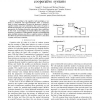Free Online Productivity Tools
i2Speak
i2Symbol
i2OCR
iTex2Img
iWeb2Print
iWeb2Shot
i2Type
iPdf2Split
iPdf2Merge
i2Bopomofo
i2Arabic
i2Style
i2Image
i2PDF
iLatex2Rtf
Sci2ools
CISS
2008
IEEE
2008
IEEE
Adversarial interference models for multiantenna cooperative systems
Abstract— According to the cognitive radio paradigm, a terminal or subsystem will opportunistically select a frequency band for data transmission. Because the spectrum is shared, a cognitive system may face interference that cannot be given a statistical description. An adversarial interference model may be appropriate for finding achievable rates under these conditions. In this work we investigate the benefit offered by using many antennas. In addition to adding spatial diversity and multiplexing gains, multiple antennas can allow a cognitive system to mitigate the effects of adversarial interference that is known to come from a system with fewer antennas.
Adversarial Interference | Adversarial Interference Model | CISS 2008 | Cognitive Radio Paradigm | Information Management |
| Added | 29 May 2010 |
| Updated | 29 May 2010 |
| Type | Conference |
| Year | 2008 |
| Where | CISS |
| Authors | Anand D. Sarwate, Michael Gastpar |
Comments (0)

